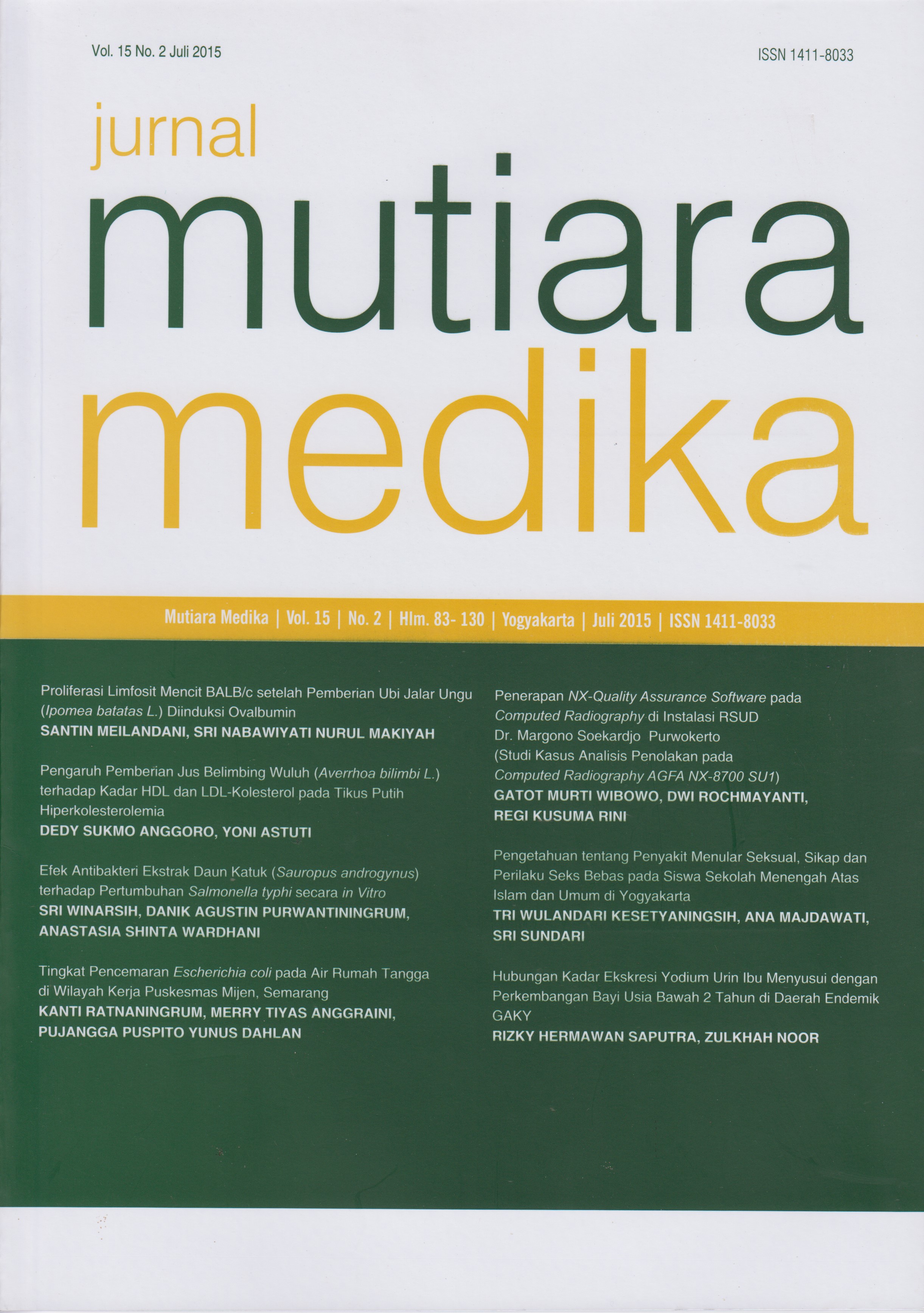Efek Antibakteri Ekstrak Daun Katuk (Sauropus androgynus) terhadap Pertumbuhan Salmonella Typhi secara In Vitro
DOI:
https://doi.org/10.18196/mmjkk.v15i2.3755Keywords:
Salmonella typhi, Sauropus androgynus leaves extract, antibacteria, in vitro, Sauropus androgynus, antibakteriAbstract
Daun Katuk biasa digunakan sebagai obat tradisional terhadap berbagai macam penyakit termasuk mengobati diare. Kandungan daun Katuk yang diperkirakan berperan sebagai antibakteri adalah saponin, flavonoid dan tannin. Penelitian ini bertujuan untuk mengetahui efek antibakteri dari ekstrak daun Katuk secara in vitro. Metode yang digunakan adalah dilusi tabung yang terdiri dari dua tahap yaitu tahap penentuan Kadar Hambat Minimum (KHM) dan Kadar Bunuh Minimum (KBM). Konsentrasi ekstrak daun Katuk yang digunakan adalah 10%, 15%, 20%, 25% dan 30%, sedangkan konsentrasi S. typhi adalah 106 CFU/ml. Hasil menunjukkan bahwa KHM ekstrak daun Katuk terhadap S. typhi sebesar 25% dan KBM nya sebesar 30%. Uji Anova menunjukkan bahwa ekstrak daun Katuk secara signifikan menghambat pertumbuhan S. typhi (p = 0.000). Uji korelasi menggunakan regresi menunjukkan terdapat korelasi negatif antara konsentrasi ekstrak daun Katuk dengan jumlah koloni S. typhi (p = 0,000; r = - 0,800). Dapat disimpulkan bahwa ekstrak daun Katuk memiliki efek antibakteri terhadap S. Typhi. Semakin tinggi kosentrasi ekstrak daun Katuk, semakin rendah jumlah koloni.Katuk (Sauropus androgynus) leaves is used as a traditional medicine against various diseases include diarrhea. The estimated antibacterial substances of Katuk leaves are saponin, flavonoid and tannin. The aim of this research is to know antibacterial effect of Katuk leaves extract against Salmonella typhi in vitro. Antibacterial effect is determined by tube dilution method, which consists of two steps, namely the determination of Minimum Inhibitory Concentration (MIC) and Minimum Bactericide Concentration (MBC). The concentrations of Katuk Leaves extracts are 10%, 15%, 20%, 25%, and 30%. The concentration of S. typhi is 106 CFU/ml. The result shows that MIC and MBC of the Katuk leaves extract are 25% and 30% respectively. Anova test shows that Katuk leaves extract significantly inhibits the growth of S. typhi (p = 0,000). Correlation test by using regression shows that there is a negative correlation between the Katuk leaves extract concentration and the amount of S. typhi colony (p= 0,000; r = - 0,800). The conclusion is that Katuk leaves has antibacterial effect against S. typhi. The higher concentration of Katuk leaf extract, the lower the number of colonies
References
Darmowandowo. Kajian tentang Demam Tifoid. 2006. (Online), diakses dari http://ummusalma. word press.com/2007/01/22/hello-world/ diakses pada 14 November 2007.
Simanjuntak, C.H. Demam Tifoid, Epidemiologi dan Perkembangan Penelitian. Cermin Dunia Kedokteran. No. 83. 2009.
WHO, The Diagnosis, Treatment and Prevention of Typhoid Fever. Geneva: Department of Vaccines and Biologicals. 2003.
Prasetyo, R. dan V. Ismoedijanto. Metode Diagnostik Demam Tipoid pada Anak. Divisi Tropik dan Penyakit Infeksi. Bagian/SMF Ilmu Kesehatan Anak FK UNAIR. 2009.
Wahjono H. Penggunaan Antibiotika secara Rasional pada Penyakit Infeksi. Medika. 1994; 25.
Meers, P. 1994. Hospital Infection Control for Nurses 1st Ed. London: Chapman and Hall. P:163.
Wikipedia. Daun Katuk dan Vitalitas. 2006. (Online), diakses dari http://www. Wikipedia Nusaindah.tripod.com/files/cdk, 8 diakses pada 13 November 2007.
Azis Sriana, S.R., dan Muktiningsih. Studi Manfaat Daun Katuk (Sauropus Androgynus). Cermin Dunia Kedokteran (CDK), 2006; 151: 48-50
Lukito, H. Rancangan Penelitian, Suatu Pengantar. Malang: IKIP Malang. 1998.
Cowan, MM. Plant Products as Antimicrobial Agents, Clin Microbiol Rev, 1999; 12 (4): 565– 571.
Prakoso, B. Pemanfaatan Tanaman Obat Tradisional di Indonesia. 2006. (Online), diakses dari http://sehatherbal.blogspot.-com/2006_12_01_ archive.html diakses pada 13 November 2007.
Downloads
Issue
Section
License
Copyright
Authors retain copyright and grant Mutiara Medika: Jurnal Kedokteran dan Kesehatan (MMJKK) the right of first publication with the work simultaneously licensed under an Attribution 4.0 International (CC BY 4.0) that allows others to remix, adapt and build upon the work with an acknowledgment of the work's authorship and of the initial publication in Mutiara Medika: Jurnal Kedokteran dan Kesehatan (MMJKK).
Authors are permitted to copy and redistribute the journal's published version of the work (e.g., post it to an institutional repository or publish it in a book), with an acknowledgment of its initial publication in Mutiara Medika: Jurnal Kedokteran dan Kesehatan (MMJKK).
License
Articles published in the Mutiara Medika: Jurnal Kedokteran dan Kesehatan (MMJKK) are licensed under an Attribution 4.0 International (CC BY 4.0) license. You are free to:
- Share — copy and redistribute the material in any medium or format.
- Adapt — remix, transform, and build upon the material for any purpose, even commercially.
This license is acceptable for Free Cultural Works. The licensor cannot revoke these freedoms as long as you follow the license terms. Under the following terms:
Attribution — You must give appropriate credit, provide a link to the license, and indicate if changes were made. You may do so in any reasonable manner, but not in any way that suggests the licensor endorses you or your use.
- No additional restrictions — You may not apply legal terms or technological measures that legally restrict others from doing anything the license permits.






